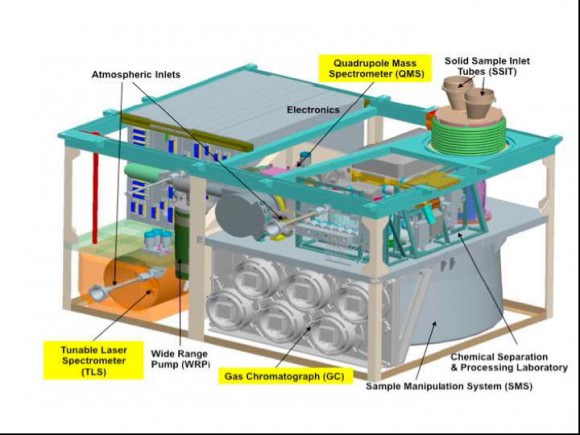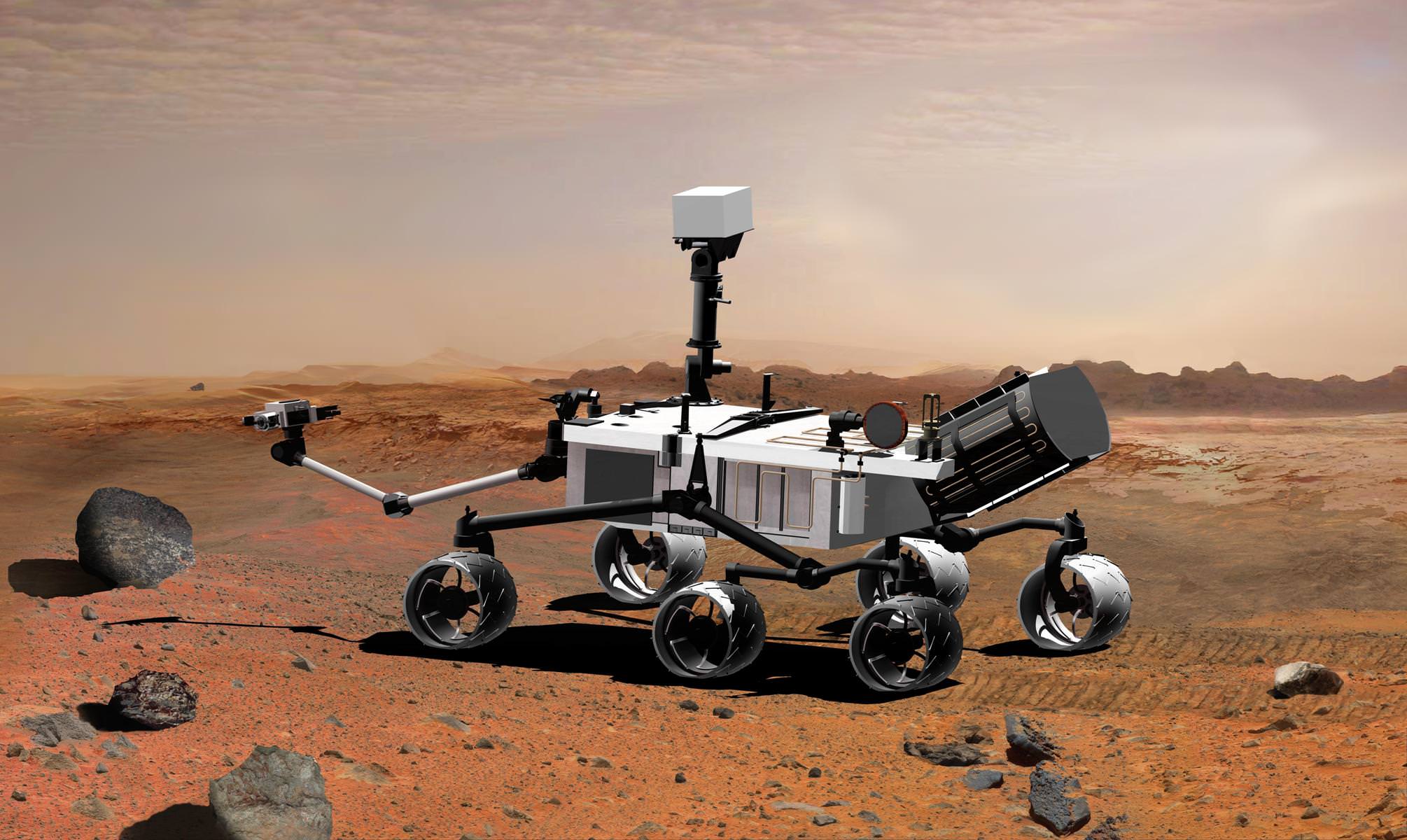[/caption]
After 36 years of debate, confusion, and failed attempts by other space agencies to answer a basic question, NASA’s Mars Science Laboratory (MSL) is on its way to repeat the search for organic matter that eluded the two Viking probes.
With 96 days left until landing, MSL will touch down at the Gale Crater this August. The rover, called Curiosity, will be the largest vehicle delivered to our neighboring planet thus far. Weighing in at 900 kg, Curiosity is nearly five times as large as the Spirit and Opportunity rovers that landed eight years ago, and more than 1.5 times as large as each Viking lander that arrived on planet in 1976.
Like the Vikings and Mars Exploration Rovers, Curiosity was conceived and launched, largely to gather information that may tell us whether the Red Planet harbors microbial life. Instrumentation launched for in situ analysis has been advancing steadily since the Viking era, yet each chapter in the story of the search for Martian life builds upon the previous ones.
Though usually mentioned only briefly in the days when Spirit and Opportunity were making headlines, the twin Viking landers were amazing craft, not only for their time, but even for today. The instrument suite of each Viking lander included a suite of three biology experiments, instruments designed for the direct detection of microbes, should the regolith at either of the two Viking landing sites contain any. While subsequent landing craft have carried instruments designed to assess Mars’ potential for life, none since the Project Viking has been built to look for Martian life forms directly.
According to Viking investigator Gilbert Levin, the Viking landers already discovered Martian life. Back in 1976-1977, Levin’s instrument, known as the Labeled Release (LR) experiment, yielded positive results at Chryse Planitia and Utopia Planitia, the two Viking landing sites. When treated with a solution containing small, organic chemicals labeled with radioactive carbon, regolith samples taken at the landing sites released a gas, indicated by an increase in radioactivity in the space above the sample.
While Levin believes the gas is carbon dioxide resulting from the oxidation of the organic chemicals, it’s also conceivable that the chemicals were reduced to another gas, methane. Either way, since heating the samples to a temperature high enough to kill most of the microbes that we know on Earth prevented the gas release, the Viking science team concluded initially that the LR had detected life.
Most of the science team, but not Levin, decided that the gas release in the LR must have resulted from a non-biological chemical reaction. This rethinking was due to variety of factors, but the most important of which was that the gas chromatograph-mass spectrometer (GC-MS) of each lander failed to detect organic matter in the samples. As the late Carl Sagan explained it on his television series, Cosmos, “If there is life on Mars, where are the dead bodies?”
While most astrobiologists and planetary scientists do not agree with Levin that the results of his 36 year-old experiment constitute conclusive evidence for Martian life, there is a growing number of Mars scientists who are equivocal on the issue. According to Levin, Sagan moved into the equivocal category in 1996, after astrobiologist David McKay and colleagues published a paper in the journal Science describing fossilized life in meteorite ALH84001, one of a handful of meteorites known to be from Mars.

Traveling within Curiosity’s enormous instrument package is a suite of machines called SAM, which stands for “Sample Analysis at Mars”. After all of these years, SAM represents NASA’s first attempt to repeat Viking’s search for Martian organics, but with more advanced technology.
This is not to say that other attempts were not made during the intervening years. In 1996, the Russian Federal Space Agency launched a Mars-bound probe carrying not only organic chemistry equipment but an upgraded version of Levin’s experiment. Rather than treating regolith samples with a mixture of “right-handed” and “left-handed” forms of organic substrates (known in chemistry as racemic mixtures), the new LR would have treated some samples with a left-handed substrate (L-cysteine) and others with the substrate’s mirror image (D-cysteine).
Had results been the same for L- and D-cysteine, a non-biological mechanism would have seemed all the more likely. However, if the active agent in the Martian regolith favored one compound at the expense of the other, this would indicate life. Even more intriguing: if the active agent favored D-cysteine, it would have suggested an origin of life on Mars separate from the origin of life on Earth, since terrestrial life forms use mostly left-handed amino acids. Such a result would suggest that life originates fairly easily, implying a cosmos teaming with living forms.
But Russia’s Mars ’96 probe crashed in the Pacific Ocean shortly after liftoff. A few years later, the European Space Agency sent Beagle 2 to Mars, carrying an advanced organic detection package, but this probe too was lost.
While Curiosity’s SAM does not include an LR experiment of any sort, it does have organic matter detection capability that can operate in mass spectrometry (MS), or gas chromatography-mass spectrometry (GS-MS) mode. In addition to being able to detect certain classes of organic compounds that the Viking GCMS would have missed in surface material, SAM also is designed to look for methane in the Martian atmosphere. Though atmospheric methane already has been detected already from orbit, detailed measurements of its concentration and fluctuations will help astrobiologists to determine whether the source is methane-producing microorganisms.


like Victoria answered I am in shock that any body able to earn $5071 in 4 weeks on the computer. have you read this webpage ===>> http://starjob.blogspot.in/
cant wait!!!!!!!
Much of the background for this excellent discussion can be found in the files at http://www.marsnow. info along with a link to a set of tapes from an interview with Gerald Soffen at the time the Viking data was collected.
This entire strategy of follow the water then follow the carbon was detailed in the MSL press kit. Finally, the Curiosity experiments are being posited in the context of previous truely scientific findings that deserve additional research and credit to Gulliver/Levin when the missing “bodies” are found.
If the Viking results are so controversial, why don’t we simply try again with one of our many probes that we have sent to Mars?
The results aren’t controversial because the experiments suffered some malfunction, but rather because when they were designed we didn’t know enough about martian soil chemistry to design experiments that would produce conclusive results. That may well still be the case. “Inconclusive” is literally the worst result you can get in science, so NASA is following the approach of dotting all of its i’s and crossing all of its t’s before they send the next viking-style experiment (or, as was originally the plan, doing a sample return mission).
I would rather describe it as the Vikings were looking for extant lifeforms as the article describes, but the spectacular failure of the experiments to test the issue either by ruling them in or out has meant later crafts have been scaled back. This is why you won’t see labeled release experiments.
Nor should you, this is not how we detect extant or extinct life on Earth. By looking for water, paleontologists (as well as astrobiologists) know better if and where one would look for preserved organics, as Curiosity is now set to do. Organics would inform either on potentials or fossils of biospheres.
Finding fossils, even trace fossils, is a meticulous task. Recognizing unicellular organisms and their diversity can be that too.
Yes, but the ALH84001 observations were similar to LR experiments, inconclusive at best.
The main reason there is more hope for extant or extinct life today may be the findings of oxidizers like perchlorates (I would think.) Those _would_ break down organics during heating for MS preparation. But not necessarily being aggressive to organics in cold and dry conditions like on Mars, and in fact being excellent energetic nutrient sources in such conditions here on Earth. (As seen in the Atacama desert.)
Producing methane to gain energy is metabolically difficult. Phylogenetic studies suggests that methanogenesis derives from earlier aerobic methylotrophy and hence derives after our Great Oxygenation Event.
Recent support for this comes from an interesting paper deriving the metabolic LUCA. (“The Emergence and Early Evolution of Biological Carbon-Fixation“, Braakman & Smith, PLoS Comp. Bil., April 2012.)
The ancestral metabolic UCA may have had little regulatory sophistication but used duplication and crosslinking of metabolic pathways for robustness. If so, the later LUCA diverged into metabolic niches under the terrible onslaught of poisonous to oxygen (GOE). One late derived metabolic phenotype, over loss of an oxidative glycine pathway, was methanogens. (See fig 5.)
[Note the seeming inconsistency that the oxygenating photosynthesizers of cyanobacteria are late derivative too. But a magazine commentary at the time pointed out a paper which indicated massive oxygenation happened from UV breakdown of water ices. Meaning that the global glaciations at the time primed the GOE process and was the source of, and not result of, oxygenating metabolism.]
So maybe methane is an indication of a biosphere, and a widely divergent one at that. Certainly Mars have had as much ice or more ice as an oxygen source and driver for metabolic divergence.
Or perhaps the biosphere on most inhabited planets is very dull indeed, with robust but non-divergent prokaryotes living on meager energy sources of geological origin.
The answer to all of this is simple. Send a robotic rover with an electron scanning microscope on it. All of this “find the water”, “look for the possible habitats of life” represents the following: the continuation of scientists careers until they retire. They all know that, most likely, there is microbial life on Mars. Let’s get on with it and explore Mars to figure out how life there came about. Curiosity rover is an EXTREMELY risky landing maneuver. If it fails, it will be a 2.5 billion dollar horror show. If it succeeds, it at best, will only show us that life can or could or may have existed on Mars. Unless of course Curiosity rolls up on a fossilized Trilobites’ evolutionary equivalent.
Let’s hope that happens.
as Helen said I am in shock that a student can get paid $6990 in 4 weeks on the computer. have you seen this page ===>> http://seekwork2home.blogspot.com/
What was inconclusive of the Viking LR? All runs on Mars at both landing sites are full positives by mission protocols (including the adjusted additional LR experiments). Even the other biology experiments yielded data which could be consitent with biology and/or at the very least exotic chemistry in the soil. What if the Viking GC/MS really yielded a false negative regarding organics on Mars due to the presence of perchlorate? MSL could shed some light on this and all the over-sceptical scientists really should start to think about the amazing Viking biology experiements results and not ignoring them anymore trieng to convince us on a sterile Mars.
Unique chemical reactions on the Mars surface are a given, doesn’t that imply that if there is life on Mars it might use one or some unique reaction(s) for energy?
Wikiup – “The Phoenix lander returned data showing Martian soil to be slightly alkaline and containing elements such as magnesium, sodium, potassium and chloride.” All of these elements are easily ionized and are found in our blood.